Unit 13 We're trying to save the earth! Section A 语法课课件(共有PPT76张)
文档属性
| 名称 | Unit 13 We're trying to save the earth! Section A 语法课课件(共有PPT76张) |  | |
| 格式 | pptx | ||
| 文件大小 | 2.3MB | ||
| 资源类型 | 教案 | ||
| 版本资源 | 人教新目标(Go for it)版 | ||
| 科目 | 英语 | ||
| 更新时间 | 2022-04-15 10:01:26 | ||
图片预览


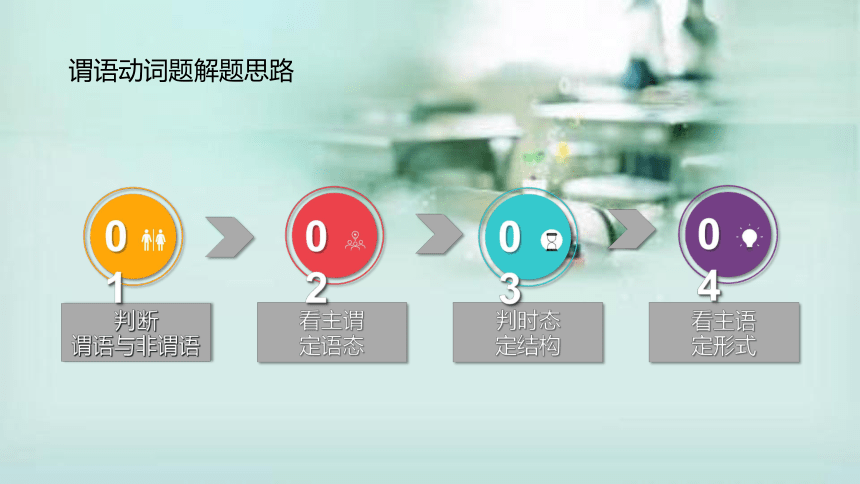

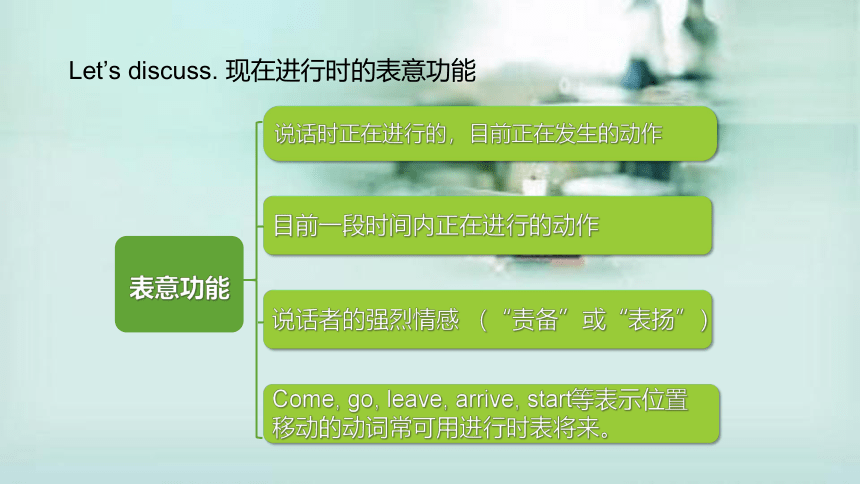
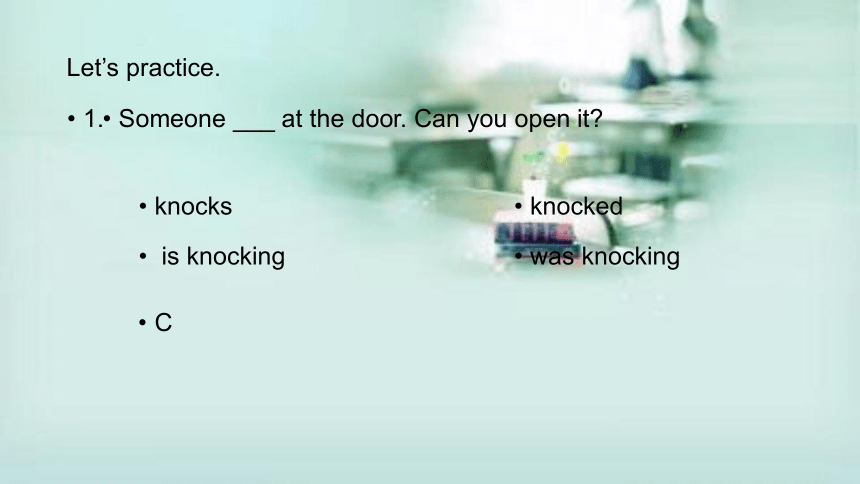
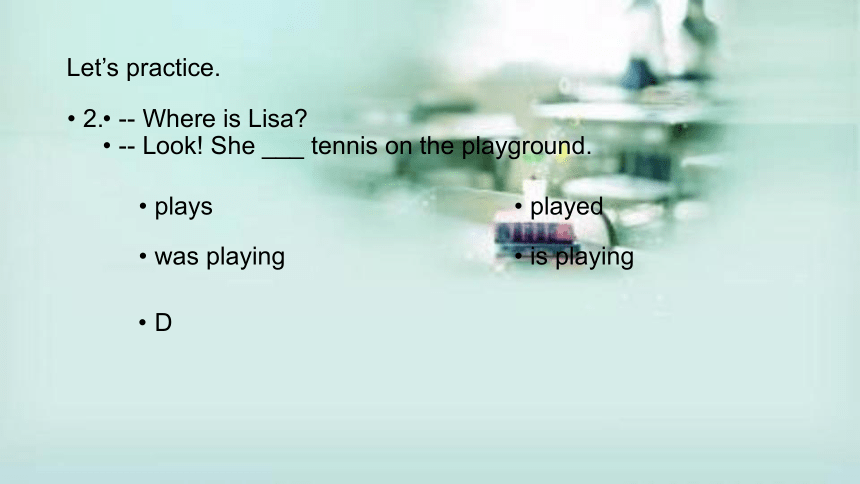
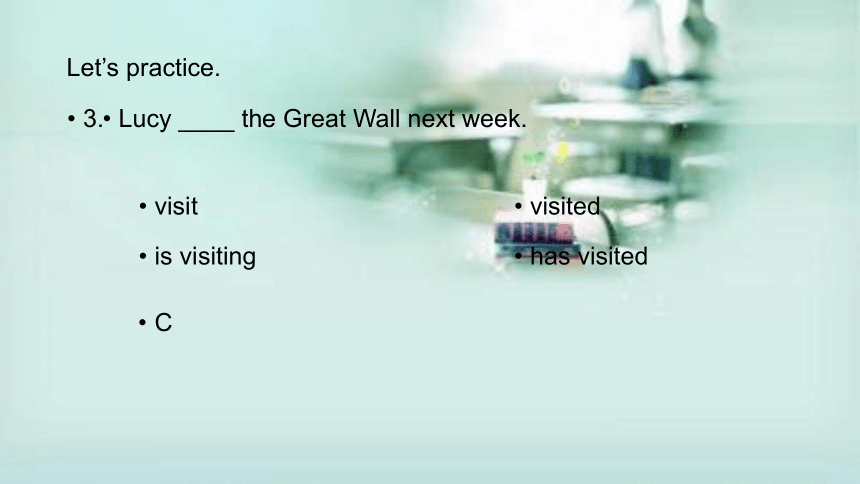
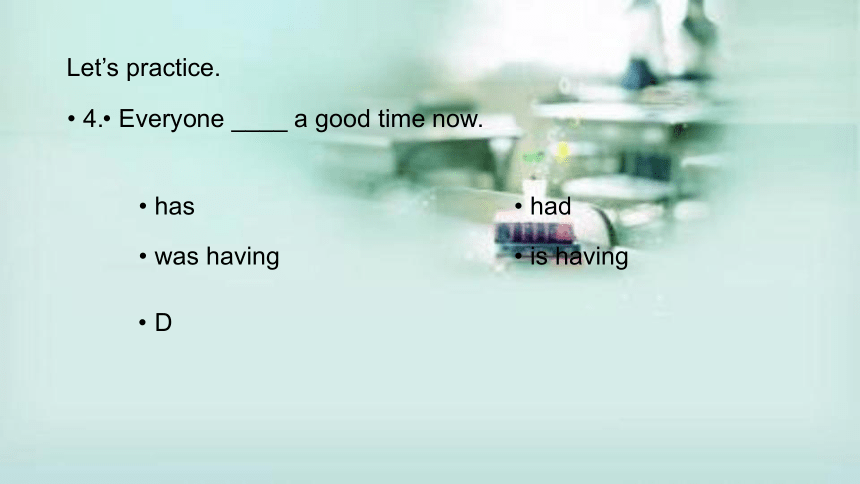



文档简介
(共76张PPT)
We’re trying to save the earth!
Unit13 Grammar Focus
学习目标
通过归纳总结的复习活动,能够掌握谓语动词的解题思路。
通过了解谓语动词解题思路,能够复习现在进行时、现在完成时、被动语态、used to的表意功能和用法。
通过小小命题官的活动,能够通过运用解题思路领悟语法项目的意义和用法。
谓语动词题解题思路
判断
谓语与非谓语
看主谓
定语态
判时态
定结构
看主语
定形式
03
02
01
04
Let’s think.
1. (广东中考)
-- Jackson, I haven’t seen you these days.
-- I _________ for the coming English test.
A. am preparing B. will prepare
C. prepare D. have prepared
判断
谓语与非谓语
判时态
定结构
可以根据时间、频度状语、句意、语境,以及问句、答语的暗示
由these days判断为现在进行时
Let’s discuss. 现在进行时的表意功能
说话时正在进行的,目前正在发生的动作
目前一段时间内正在进行的动作
说话者的强烈情感 (“责备”或“表扬”)
Come, go, leave, arrive, start等表示位置移动的动词常可用进行时表将来。
表意功能
Let’s practice.
Someone ___ at the door. Can you open it
knocks
knocked
1.
is knocking
was knocking
C
Let’s practice.
-- Where is Lisa
-- Look! She ___ tennis on the playground.
plays
played
2.
was playing
is playing
D
Let’s practice.
Lucy ____ the Great Wall next week.
visit
visited
3.
is visiting
has visited
C
Let’s practice.
Everyone ____ a good time now.
has
had
4.
was having
is having
D
Let’s practice.
-- Hurry up! We ______for you at the gate.
-- I’m sorry. I’m coming now.
wait
will wait
5.
have been wait
are waiting
D
Let’s think.
1. (江苏中考)
-- Excuse me, where is Mr. Wu
-- He _________ for the foreign students at the school gate. (wait)
判断
谓语与非谓语
看主谓
定语态
可以根据时间、频度状语、句意、语境,以及问句、答语的暗示
由问句判断为现在进行时
he与wait为主动关系
判时态
定结构
现在进行时的结构?
Let’s review. 现在进行时的结构
肯定句:主语+be动词+动词现在分词+其它
否定句:主语+be动词+not+动词现在分词+其它
一般疑问句:be动词+主语+动词现在分词+其它
特殊疑问句:疑问句+一般疑问句
句型结构
Let’s think.
1. (江苏中考)
-- Excuse me, where is Mr. Wu
-- He _________ for the foreign students at the school gate. (wait)
看主语
定形式
is waiting
is waiting
Let’s practice.
1. (浙江中考)
The child _________ over there. What’s wrong with him (cry)
is crying
2. (江苏中考)
-- What are Paul and Bob doing these days
-- They ___________________ a survey of after-school activities. (carry out)
are carrying out
Let’s think.
1. (2021广西)
I used to _______ at half past six, but now I am getting used to _______ at seven.
A. getting up; get up B. get up; getting up
C. got up; getting up D. got up; get up
判断
谓语与非谓语
非谓语
考虑固定搭配
Let’s review. used to表意功能与结构
表意功能:描述过去的习惯或状况
结构:used to+动词原形
used to
Let’s think.
1. (2021广西)
I used to _______ at half past six, but now I am getting used to _______ at seven.
A. getting up; get up B. get up; getting up
C. got up; getting up D. got up; get up
考虑
固定搭配
Let’s practice.
There _____ a lot of trees here, but now it has become desert.
is
have
1.
used to be
used to being
C
Let’s practice.
I’ll never forget the town in which there _____ a clean river and many big tall trees.
used to be
used to have
2.
was used to being
was used to having
A
Let’s practice.
3. His father used to _______ (stay) at home, but now he is used to _______ (take) a walk after dinner.
stay
taking
Let’s think.
1.
-- Tina, I think more attention _______ to your handwriting.
-- OK, I will try my best.
A. should is paid B. should pay
C. should be paid
判断
谓语与非谓语
看主谓
定语态
attention与pay为被动关系
被动语态
结构为?
Let’s review. 被动语态表意功能
讲话者不知道动作的执行者,不必或不便说出动作的执行者(这时可省掉by引导的短语)
借助被动的动作突出动作的承受者
为了更好的安排句子,用于修辞
当动作的执行者是无生命的事物时,需用被动语态
用法
有些动词习惯被动语态,如born, report, say等
Let’s review. 被动语态结构
一般时
进行时
完成时
时态
现在am/is/are+过去分词
过去was/were+过去分词
将来will/shall be+过去分词
过去将来would/should be+过去分词
现在am/is/are being+过去分词
过去was/were being+过去分词
现在have/has been+过去分词
过去had been+过去分词
将来will/shall have been+过去分词
过去将来would/should have been+过去分词
Let’s review. 被动语态结构
不同结构的被动语态
肯定句式被动语态的基本结构是:主语+be动词+过去分词+其他。
否定句式被动语态的基本结构是:主语+be动词+not+过去分词+其他。
一般疑问句式被动语态的基本结构是:Be动词+主语+过去分词+其他。
特殊疑问句被动语态的基本结构是:特殊疑问词+be动词+主语+过去分词+其他。
get+过去分词
这个要强调动作的发生,基本结构是:主语+get+过去分词+其他。
有情态动词的被动语态基本结构是:主语+情态动词+be+过去分词+其他。
Let’s think.
1. -- Tina, I think more attention _______ to your handwriting .
-- OK, I will try my best.
A. should is paid B. should pay C. should be paid
Let’s practice.
1. (上海中考) Doctor Wu Mengchao saved a lot of patients’ lives. (改为被动语态)
A lot of patients’ lives ___________ by Doctor Wu Mengchao.
were saved
Let’s practice.
(湖北中考)
-- How clean your bike is!
-- Thank you. It ______ very often.
is washed
washes
1.
was washing
washed
A
Let’s think.
1.
This kind of pen ______, and is also very cheap. I think you can buy some.
A. writes well B. writes good
C. is written well D. is written good
判断
谓语与非谓语
看主谓
定语态
pen与write为被动关系
Let’s discuss. 主动表被动
感官动词
smell, taste, prove, sell
want/need/require doing
be worth doing
主动表
被动
break out, happen, take place, come out, come true, run out
Let’s think.
1.
This kind of pen ______, and is also very cheap. I think you can buy some.
A. writes well B. writes good
C. is written well D. is written good
判断
谓语与非谓语
看主谓
定语态
pen与write为被动关系
A
Let’s practice.
(四川中考)
-- Where will the 2022 Winter Olympics ____ , Cindy
-- In Beijing, the capital of China, the first city to host both Summer and Winter Olympics.
be taken place
take place
1.
take part
be taken part
B
Let’s practice.
2. (黑龙江中考) I heard a girl sing in the next room. (改为被动语态)
A girl ______ heard _____ sing in the next room.
was to
Let’s think.
1.
-- What great progress Huawei _________ in recent years!
-- No wonder it is widely known in all parts of the world.
A. is making B. has made
C. makes D. made
判断
谓语与非谓语
看主谓
定语态
现在完成时的表意功能与结构?
可以根据时间、频度状语、句意、语境,以及问句、答语的暗示
由in recent years判断为现在完成时
判时态
定结构
主动关系
Let’s review. 现在完成时的表意功能
表示动作发生在过去,并对现在有影响.
表意功能
某一动作或状态从过去开始,一直持续到现在并有可能持续下去。
Let’s review. 现在完成时的结构
肯定句:have/has done
否定句:have/has not done
一般疑问句:Have/Has+主语+done+其它
特殊疑问句:
特殊疑问词+have/has+主语+done+其它
句型结构
被动语态:have/has been done
Let’s think.
1.
-- What great progress Huawei _________ in recent years!
-- No wonder it is widely known in all parts of the world.
A. is making B. has made
C. makes D. made
看主语
定形式
B
Let’s practice.
-- Mary, I remember you ________ several years ago.
-- Yes, I ________ for 3 years.
married, have married
married, married
1.
got married, have been married
have married, have been married
C
Let’s practice.
-- Your new bike is so nice! When did you buy it?
-- In July. I_______ it for two weeks.
had
have had
2.
have bought
bought
B
Let’s practice.
-- It’s ten years since we came here.
-- How time flies! We__________ in China for so long.
work
worked
3.
will work
have worked
D
Let’s think.
1.
-- Linda has ______ to Paris. How can I get in touch with her?
-- Don’t worry. She will call you as soon as she ______ there.
A. been; will get B. been; gets
C. gone; will get D. gone; gets
判断
谓语与非谓语
看主谓
定语态
has been to与has gone to的区别?
可以根据时间、频度状语、句意、语境,以及问句、答语的暗示
1.由has判断为现在完成时
2.as soon as判断主将从现
判时态
定结构
主动关系
Let’s review. 现在完成时的结构
have/has been to
去过某地(说话时已回来)
have/has gone to
去了某地(未回)
have/has been in
在某地待了一段时间
Let’s think.
1.
-- Linda has ______ to Paris. How can I get in touch with her?
-- Don’t worry. She will call you as soon as she ______ there.
A. been; will get B. been; gets
C. gone; will get D. gone; gets
看主语
定形式
D
Let’s practice.
-- Where is Tommy Do you know
-- I think he_________ to the library.
has gone
goes
1.
has been
went
A
Let’s practice.
Mary _________ never _________ to the Summer Palace in Beijing.
has; been
has; gone
2.
has; goes
is; goes
A
Let’s practice.
My family _________ England since 1998.
have been to
has gone to
3.
has been in
went to
C
4a
Joe: ______ you ever ______ (take) part in an
environmental project
Ken: Yes, I have. I _______ (help) with a Clean-Up Day
last year. It was __________ (consider) the biggest
clean-up project this city ____ ever ____ (have).
Joe: How many people _____ (take) part
Have
taken
helped
considered
had
had
took
Fill in the blanks with the correct forms of the verbs in brackets.
Ken: I _____ (think) more than 1,000 people _____
(come) to help out.
Joe: That’s fantastic! I guess everyone in this city is
_______ (try) to improve the environment.
Ken: Yes, we can’t afford to _____ (wait) any longer
to take action!
think
came
trying
wait
小小命题官
According to the skills you have learned, make up exercises with each grammar rule in your group.
每组出2道单选,2道适当形式填空,1道翻译。
Let’s check.
评价内容 1 2 3 4 5
能够掌握谓语动词的解题思路。
能够复习现在进行时、现在完成时、被动语态、used to的表意功能和用法。
能够通过运用解题思路领悟语法项目的意义和用法。
can
would
could
have to
should
must
may/might
People __________ think that big things __________________ be done to save the earth. Many forget that saving the earth begins with small things. For example, you ______________ save electricity by turning off the lights when you leave a room. You _______________ also use reusable bags instead of plastic bags.
may/might
must/have to/should
can/could/should
can/could/should
Fill in the blanks with the appropriate modal verbs from the box.
4b
I think it’s a great idea that you now _______ pay for plastic bags in some stores. And instead of driving to school or work, you ________________ ride your bike or walk. If it’s far, you __________ take the bus. All these small things _________ add up and become big things that _________________ improve the environment. Let’s take action now!
have to
can/could
can/could
would/can/could
can/could/should
Fill in the blanks with the appropriate modal verbs.
Make a list of things that people can do to help the environment and discuss your list with your partner.
Pollution Present situation Reasons Ways to help
4c
Let’s think. 情态动词学习要点
表推测
01
表委婉、建议、能力
02
表义务
03
Let’s discuss.
We can do it by ourselves.
It must be Tom’s. Look at his name on the cover.
3. We should help save the sharks.
4. Must I take an umbrella tomorrow
表能力
表推测
表委婉
表义务
你知道情态动词可以表达多少种含义吗?
Let’s review. 情态动词:表推测
-- I saw Lily in the supermarket this morning.
-- Oh, it ________ her. She moved to Australia the day before yesterday.
can be
must be
1.
can’t be
mustn’t be
C
你知道哪些情态动词可以表达推测吗?
Let’s review. 情态动词:表推测
After a long walk, the children ________ be very tired now.
will
must
2.
have to
can
B
Let’s review. 情态动词:表推测
John ________ go with us tomorrow, but he isn’t sure.
must
can
3.
need
may
D
It can’t be her.
Mum thought I might be cold. So I’ve brought some warm clothes.
表“推测”:might/could, may, can, must
可能性依次递增。
may和must表 “推测” 常用于肯定句中,
can表 “推测” 常用于否定句和疑问句中。
Let’s review. 情态动词:表推测
你知道哪些情态动词可以表达推测吗?
Let’s practice.
This pair of glasses ______ be Tony’s. He’s the only one who wears glasses in our classroom.
must
might
1.
can’t
could
A
Let’s practice.
-- Excuse me, where is the nearest bank
-- Go straight ahead; you __________ miss it.
mustn’t
can’t
2.
needn’t
shouldn’t
B
Let’s practice.
-- Have you decided which city to visit
-- Not yet. I __________ go to Baotou.
need
must
3.
may
should
C
Let’s review. 情态动词:表委婉、建议、能力
你知道哪些情态动词可以表达这些含义吗?
Let’s review and practice.
-- ________ your Australian friend eat with chopsticks
-- Yes, but she can’t use them well.
Should
Need
1.
Can
Must
C
Let’s review and practice.
-- Could your father play golf when he was young
-- No, he ________. But he ________ play table tennis.
couldn’t; could
needn’t; might
2.
mustn’t; should
shouldn’t; need
A
Let’s review and practice.
-- ________ I borrow your maths book
-- Sure. Here you are.
Need
Will
3.
May
Must
C
Let’s review and practice.
You ________ study hard if you want to be a scientist in the future.
may
should
4.
would
could
B
Let’s summarize. 情态动词:表委婉、建议、能力
表委婉:__________________.
你知道哪些情态动词可以表达这些含义吗?
may/might, can/could
表建议:__________________.
shall/should
表能力:__________________.
can/could,
be able to
Let’s review and practice. 情态动词:表义务
Jim, you ________ play with the knife.
You ________ hurt yourself.
won’t; can’t
mustn’t; may
1.
shouldn’t; must
can’t; shouldn’t
B
Let’s review and practice. 情态动词:表义务
-- ________ I have to hand in my homework now, Mr. Zhang
-- Yes, you do.
Do
Can
2.
May
Must
A
Let’s review and practice. 情态动词:表义务
-- We’ve got everything ready for the picnic.
-- Do you mean I ________ bring anything with me
can’t
needn’t
3.
couldn’t
mustn’t
B
Let’s review and practice. 情态动词:表义务
-- Must I get up before six o’clock tomorrow morning, Dad
-- No, you ________. Tomorrow is Saturday. You may get up a little later.
mustn’t
can’t
4.
needn’t
may not
C
Let’s review and practice. 情态动词:表义务
It’s too late. We ________ go home, or we’ll be blamed (责备).
can
may
5.
might
have to
D
Let’s summarize.
表义务:
__________________.
你知道哪些情态动词可以表达义务的含义吗?
must, need, have to
Let’s discuss.
Ken can climb up the tree like a koala.
Tracy could ride a bicycle when she was five years old.
You mustn’t play with fire. It is dangerous.
情态动词可以单独做谓语吗?
不能单独作谓语, 只能与其他动词构成谓语。
Let’s sum up. 情态动词学习要点
情态动词可以表达含义分别是:
推测:might, could, may, can, must, can’t
义务:must, have to, need
委婉:may/might, can/could
能力:can, be able to
建议:shall/should
Homework.
Write 5 sentences with the language points.
Make up 5 exercises with the skills.
Search for information about environmental protection and endangered animals.
We’re trying to save the earth!
Unit13 Grammar Focus
学习目标
通过归纳总结的复习活动,能够掌握谓语动词的解题思路。
通过了解谓语动词解题思路,能够复习现在进行时、现在完成时、被动语态、used to的表意功能和用法。
通过小小命题官的活动,能够通过运用解题思路领悟语法项目的意义和用法。
谓语动词题解题思路
判断
谓语与非谓语
看主谓
定语态
判时态
定结构
看主语
定形式
03
02
01
04
Let’s think.
1. (广东中考)
-- Jackson, I haven’t seen you these days.
-- I _________ for the coming English test.
A. am preparing B. will prepare
C. prepare D. have prepared
判断
谓语与非谓语
判时态
定结构
可以根据时间、频度状语、句意、语境,以及问句、答语的暗示
由these days判断为现在进行时
Let’s discuss. 现在进行时的表意功能
说话时正在进行的,目前正在发生的动作
目前一段时间内正在进行的动作
说话者的强烈情感 (“责备”或“表扬”)
Come, go, leave, arrive, start等表示位置移动的动词常可用进行时表将来。
表意功能
Let’s practice.
Someone ___ at the door. Can you open it
knocks
knocked
1.
is knocking
was knocking
C
Let’s practice.
-- Where is Lisa
-- Look! She ___ tennis on the playground.
plays
played
2.
was playing
is playing
D
Let’s practice.
Lucy ____ the Great Wall next week.
visit
visited
3.
is visiting
has visited
C
Let’s practice.
Everyone ____ a good time now.
has
had
4.
was having
is having
D
Let’s practice.
-- Hurry up! We ______for you at the gate.
-- I’m sorry. I’m coming now.
wait
will wait
5.
have been wait
are waiting
D
Let’s think.
1. (江苏中考)
-- Excuse me, where is Mr. Wu
-- He _________ for the foreign students at the school gate. (wait)
判断
谓语与非谓语
看主谓
定语态
可以根据时间、频度状语、句意、语境,以及问句、答语的暗示
由问句判断为现在进行时
he与wait为主动关系
判时态
定结构
现在进行时的结构?
Let’s review. 现在进行时的结构
肯定句:主语+be动词+动词现在分词+其它
否定句:主语+be动词+not+动词现在分词+其它
一般疑问句:be动词+主语+动词现在分词+其它
特殊疑问句:疑问句+一般疑问句
句型结构
Let’s think.
1. (江苏中考)
-- Excuse me, where is Mr. Wu
-- He _________ for the foreign students at the school gate. (wait)
看主语
定形式
is waiting
is waiting
Let’s practice.
1. (浙江中考)
The child _________ over there. What’s wrong with him (cry)
is crying
2. (江苏中考)
-- What are Paul and Bob doing these days
-- They ___________________ a survey of after-school activities. (carry out)
are carrying out
Let’s think.
1. (2021广西)
I used to _______ at half past six, but now I am getting used to _______ at seven.
A. getting up; get up B. get up; getting up
C. got up; getting up D. got up; get up
判断
谓语与非谓语
非谓语
考虑固定搭配
Let’s review. used to表意功能与结构
表意功能:描述过去的习惯或状况
结构:used to+动词原形
used to
Let’s think.
1. (2021广西)
I used to _______ at half past six, but now I am getting used to _______ at seven.
A. getting up; get up B. get up; getting up
C. got up; getting up D. got up; get up
考虑
固定搭配
Let’s practice.
There _____ a lot of trees here, but now it has become desert.
is
have
1.
used to be
used to being
C
Let’s practice.
I’ll never forget the town in which there _____ a clean river and many big tall trees.
used to be
used to have
2.
was used to being
was used to having
A
Let’s practice.
3. His father used to _______ (stay) at home, but now he is used to _______ (take) a walk after dinner.
stay
taking
Let’s think.
1.
-- Tina, I think more attention _______ to your handwriting.
-- OK, I will try my best.
A. should is paid B. should pay
C. should be paid
判断
谓语与非谓语
看主谓
定语态
attention与pay为被动关系
被动语态
结构为?
Let’s review. 被动语态表意功能
讲话者不知道动作的执行者,不必或不便说出动作的执行者(这时可省掉by引导的短语)
借助被动的动作突出动作的承受者
为了更好的安排句子,用于修辞
当动作的执行者是无生命的事物时,需用被动语态
用法
有些动词习惯被动语态,如born, report, say等
Let’s review. 被动语态结构
一般时
进行时
完成时
时态
现在am/is/are+过去分词
过去was/were+过去分词
将来will/shall be+过去分词
过去将来would/should be+过去分词
现在am/is/are being+过去分词
过去was/were being+过去分词
现在have/has been+过去分词
过去had been+过去分词
将来will/shall have been+过去分词
过去将来would/should have been+过去分词
Let’s review. 被动语态结构
不同结构的被动语态
肯定句式被动语态的基本结构是:主语+be动词+过去分词+其他。
否定句式被动语态的基本结构是:主语+be动词+not+过去分词+其他。
一般疑问句式被动语态的基本结构是:Be动词+主语+过去分词+其他。
特殊疑问句被动语态的基本结构是:特殊疑问词+be动词+主语+过去分词+其他。
get+过去分词
这个要强调动作的发生,基本结构是:主语+get+过去分词+其他。
有情态动词的被动语态基本结构是:主语+情态动词+be+过去分词+其他。
Let’s think.
1. -- Tina, I think more attention _______ to your handwriting .
-- OK, I will try my best.
A. should is paid B. should pay C. should be paid
Let’s practice.
1. (上海中考) Doctor Wu Mengchao saved a lot of patients’ lives. (改为被动语态)
A lot of patients’ lives ___________ by Doctor Wu Mengchao.
were saved
Let’s practice.
(湖北中考)
-- How clean your bike is!
-- Thank you. It ______ very often.
is washed
washes
1.
was washing
washed
A
Let’s think.
1.
This kind of pen ______, and is also very cheap. I think you can buy some.
A. writes well B. writes good
C. is written well D. is written good
判断
谓语与非谓语
看主谓
定语态
pen与write为被动关系
Let’s discuss. 主动表被动
感官动词
smell, taste, prove, sell
want/need/require doing
be worth doing
主动表
被动
break out, happen, take place, come out, come true, run out
Let’s think.
1.
This kind of pen ______, and is also very cheap. I think you can buy some.
A. writes well B. writes good
C. is written well D. is written good
判断
谓语与非谓语
看主谓
定语态
pen与write为被动关系
A
Let’s practice.
(四川中考)
-- Where will the 2022 Winter Olympics ____ , Cindy
-- In Beijing, the capital of China, the first city to host both Summer and Winter Olympics.
be taken place
take place
1.
take part
be taken part
B
Let’s practice.
2. (黑龙江中考) I heard a girl sing in the next room. (改为被动语态)
A girl ______ heard _____ sing in the next room.
was to
Let’s think.
1.
-- What great progress Huawei _________ in recent years!
-- No wonder it is widely known in all parts of the world.
A. is making B. has made
C. makes D. made
判断
谓语与非谓语
看主谓
定语态
现在完成时的表意功能与结构?
可以根据时间、频度状语、句意、语境,以及问句、答语的暗示
由in recent years判断为现在完成时
判时态
定结构
主动关系
Let’s review. 现在完成时的表意功能
表示动作发生在过去,并对现在有影响.
表意功能
某一动作或状态从过去开始,一直持续到现在并有可能持续下去。
Let’s review. 现在完成时的结构
肯定句:have/has done
否定句:have/has not done
一般疑问句:Have/Has+主语+done+其它
特殊疑问句:
特殊疑问词+have/has+主语+done+其它
句型结构
被动语态:have/has been done
Let’s think.
1.
-- What great progress Huawei _________ in recent years!
-- No wonder it is widely known in all parts of the world.
A. is making B. has made
C. makes D. made
看主语
定形式
B
Let’s practice.
-- Mary, I remember you ________ several years ago.
-- Yes, I ________ for 3 years.
married, have married
married, married
1.
got married, have been married
have married, have been married
C
Let’s practice.
-- Your new bike is so nice! When did you buy it?
-- In July. I_______ it for two weeks.
had
have had
2.
have bought
bought
B
Let’s practice.
-- It’s ten years since we came here.
-- How time flies! We__________ in China for so long.
work
worked
3.
will work
have worked
D
Let’s think.
1.
-- Linda has ______ to Paris. How can I get in touch with her?
-- Don’t worry. She will call you as soon as she ______ there.
A. been; will get B. been; gets
C. gone; will get D. gone; gets
判断
谓语与非谓语
看主谓
定语态
has been to与has gone to的区别?
可以根据时间、频度状语、句意、语境,以及问句、答语的暗示
1.由has判断为现在完成时
2.as soon as判断主将从现
判时态
定结构
主动关系
Let’s review. 现在完成时的结构
have/has been to
去过某地(说话时已回来)
have/has gone to
去了某地(未回)
have/has been in
在某地待了一段时间
Let’s think.
1.
-- Linda has ______ to Paris. How can I get in touch with her?
-- Don’t worry. She will call you as soon as she ______ there.
A. been; will get B. been; gets
C. gone; will get D. gone; gets
看主语
定形式
D
Let’s practice.
-- Where is Tommy Do you know
-- I think he_________ to the library.
has gone
goes
1.
has been
went
A
Let’s practice.
Mary _________ never _________ to the Summer Palace in Beijing.
has; been
has; gone
2.
has; goes
is; goes
A
Let’s practice.
My family _________ England since 1998.
have been to
has gone to
3.
has been in
went to
C
4a
Joe: ______ you ever ______ (take) part in an
environmental project
Ken: Yes, I have. I _______ (help) with a Clean-Up Day
last year. It was __________ (consider) the biggest
clean-up project this city ____ ever ____ (have).
Joe: How many people _____ (take) part
Have
taken
helped
considered
had
had
took
Fill in the blanks with the correct forms of the verbs in brackets.
Ken: I _____ (think) more than 1,000 people _____
(come) to help out.
Joe: That’s fantastic! I guess everyone in this city is
_______ (try) to improve the environment.
Ken: Yes, we can’t afford to _____ (wait) any longer
to take action!
think
came
trying
wait
小小命题官
According to the skills you have learned, make up exercises with each grammar rule in your group.
每组出2道单选,2道适当形式填空,1道翻译。
Let’s check.
评价内容 1 2 3 4 5
能够掌握谓语动词的解题思路。
能够复习现在进行时、现在完成时、被动语态、used to的表意功能和用法。
能够通过运用解题思路领悟语法项目的意义和用法。
can
would
could
have to
should
must
may/might
People __________ think that big things __________________ be done to save the earth. Many forget that saving the earth begins with small things. For example, you ______________ save electricity by turning off the lights when you leave a room. You _______________ also use reusable bags instead of plastic bags.
may/might
must/have to/should
can/could/should
can/could/should
Fill in the blanks with the appropriate modal verbs from the box.
4b
I think it’s a great idea that you now _______ pay for plastic bags in some stores. And instead of driving to school or work, you ________________ ride your bike or walk. If it’s far, you __________ take the bus. All these small things _________ add up and become big things that _________________ improve the environment. Let’s take action now!
have to
can/could
can/could
would/can/could
can/could/should
Fill in the blanks with the appropriate modal verbs.
Make a list of things that people can do to help the environment and discuss your list with your partner.
Pollution Present situation Reasons Ways to help
4c
Let’s think. 情态动词学习要点
表推测
01
表委婉、建议、能力
02
表义务
03
Let’s discuss.
We can do it by ourselves.
It must be Tom’s. Look at his name on the cover.
3. We should help save the sharks.
4. Must I take an umbrella tomorrow
表能力
表推测
表委婉
表义务
你知道情态动词可以表达多少种含义吗?
Let’s review. 情态动词:表推测
-- I saw Lily in the supermarket this morning.
-- Oh, it ________ her. She moved to Australia the day before yesterday.
can be
must be
1.
can’t be
mustn’t be
C
你知道哪些情态动词可以表达推测吗?
Let’s review. 情态动词:表推测
After a long walk, the children ________ be very tired now.
will
must
2.
have to
can
B
Let’s review. 情态动词:表推测
John ________ go with us tomorrow, but he isn’t sure.
must
can
3.
need
may
D
It can’t be her.
Mum thought I might be cold. So I’ve brought some warm clothes.
表“推测”:might/could, may, can, must
可能性依次递增。
may和must表 “推测” 常用于肯定句中,
can表 “推测” 常用于否定句和疑问句中。
Let’s review. 情态动词:表推测
你知道哪些情态动词可以表达推测吗?
Let’s practice.
This pair of glasses ______ be Tony’s. He’s the only one who wears glasses in our classroom.
must
might
1.
can’t
could
A
Let’s practice.
-- Excuse me, where is the nearest bank
-- Go straight ahead; you __________ miss it.
mustn’t
can’t
2.
needn’t
shouldn’t
B
Let’s practice.
-- Have you decided which city to visit
-- Not yet. I __________ go to Baotou.
need
must
3.
may
should
C
Let’s review. 情态动词:表委婉、建议、能力
你知道哪些情态动词可以表达这些含义吗?
Let’s review and practice.
-- ________ your Australian friend eat with chopsticks
-- Yes, but she can’t use them well.
Should
Need
1.
Can
Must
C
Let’s review and practice.
-- Could your father play golf when he was young
-- No, he ________. But he ________ play table tennis.
couldn’t; could
needn’t; might
2.
mustn’t; should
shouldn’t; need
A
Let’s review and practice.
-- ________ I borrow your maths book
-- Sure. Here you are.
Need
Will
3.
May
Must
C
Let’s review and practice.
You ________ study hard if you want to be a scientist in the future.
may
should
4.
would
could
B
Let’s summarize. 情态动词:表委婉、建议、能力
表委婉:__________________.
你知道哪些情态动词可以表达这些含义吗?
may/might, can/could
表建议:__________________.
shall/should
表能力:__________________.
can/could,
be able to
Let’s review and practice. 情态动词:表义务
Jim, you ________ play with the knife.
You ________ hurt yourself.
won’t; can’t
mustn’t; may
1.
shouldn’t; must
can’t; shouldn’t
B
Let’s review and practice. 情态动词:表义务
-- ________ I have to hand in my homework now, Mr. Zhang
-- Yes, you do.
Do
Can
2.
May
Must
A
Let’s review and practice. 情态动词:表义务
-- We’ve got everything ready for the picnic.
-- Do you mean I ________ bring anything with me
can’t
needn’t
3.
couldn’t
mustn’t
B
Let’s review and practice. 情态动词:表义务
-- Must I get up before six o’clock tomorrow morning, Dad
-- No, you ________. Tomorrow is Saturday. You may get up a little later.
mustn’t
can’t
4.
needn’t
may not
C
Let’s review and practice. 情态动词:表义务
It’s too late. We ________ go home, or we’ll be blamed (责备).
can
may
5.
might
have to
D
Let’s summarize.
表义务:
__________________.
你知道哪些情态动词可以表达义务的含义吗?
must, need, have to
Let’s discuss.
Ken can climb up the tree like a koala.
Tracy could ride a bicycle when she was five years old.
You mustn’t play with fire. It is dangerous.
情态动词可以单独做谓语吗?
不能单独作谓语, 只能与其他动词构成谓语。
Let’s sum up. 情态动词学习要点
情态动词可以表达含义分别是:
推测:might, could, may, can, must, can’t
义务:must, have to, need
委婉:may/might, can/could
能力:can, be able to
建议:shall/should
Homework.
Write 5 sentences with the language points.
Make up 5 exercises with the skills.
Search for information about environmental protection and endangered animals.
同课章节目录
- Unit 1 How can we become good learners.
- Section A
- Section B
- Unit 2 I think that mooncakes are delicious!
- Section A
- Section B
- Unit 3 Could you please tell me where the restroom
- Section A
- Section B
- Unit 4 I used to be afraid of the dark.
- Section A
- Section B
- Unit 5 What are the shirts made of?
- Section A
- Section B
- Review of Units 1-5
- Unit 6 When was it invented?
- Section A
- Section B
- Unit 7 Teenagers should be allowed to choose their
- Section A
- Section B
- Unit 8 It must belong to Carla.
- Section A
- Section B
- Unit 9 I like music that I can dance to.
- Section A
- Section B
- Unit 10 You're supposed to shake hands.
- Section A
- Section B
- Review of Units 6-10
- Unit 11 Sad movies make me cry.
- Section A
- Section B
- Unit 12 Life is full of the unexpected
- Section A
- Section B
- Unit 13 We're trying to save the earth!
- Section A
- Section B
- Unit 14 I remember meeting all of you in Grade 7.
- Section A
- Section B
- Review of Units 11-14
